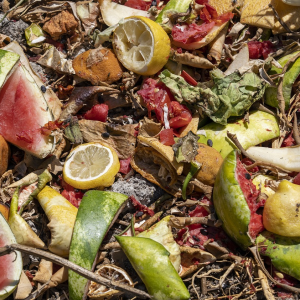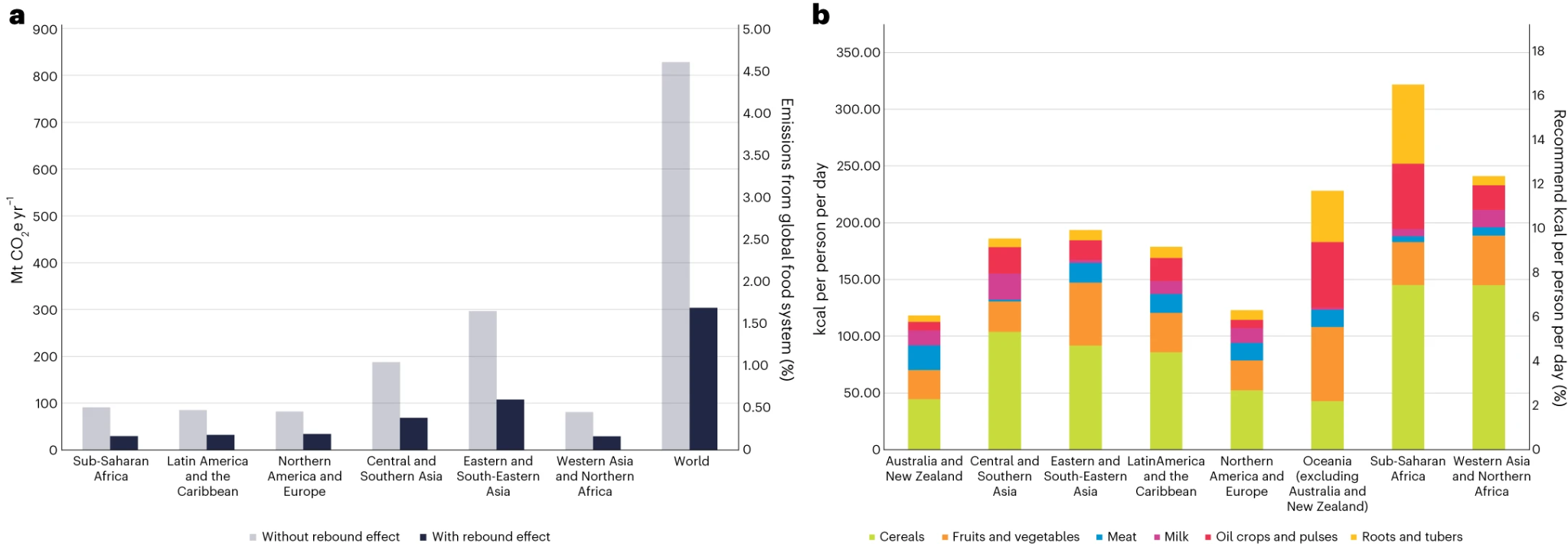
Food loss and waste is thought to contribute to 24% of greenhouse gas emissions from the global food system, which amounts to 6% of total emissions. It is generally assumed that if food loss and waste were to decrease, less food would need to be produced, which would ultimately reduce associated environmental impacts. However, this study looks at an alternative scenario where reduced food loss and waste causes a ‘rebound effect’ in which the resultant price decreases cause an increase in consumption.
To better understand potential ‘rebound effects’ the authors created an economic model to assess changes in supply and demand associated with a halving of food loss and waste globally. Using this model, the direct rebound effects of halving food loss and waste were found to range from 53% to 71% depending on the region and food product being considered. For example, rebound effects were largest for fruit and veg (64–71%), and slightly less for cereals (58-68%) and meat and dairy (53-61%). Moreover, rebound effects were found to be higher in low- and middle-income groups than high-income groups, owing to relatively high supply elasticities, the responsiveness of supply to a change in market price, and low demand elasticities, a more constant demand for food regardless of price.
The authors also examined how these rebound effects would offset any environmental benefits associated with halving food loss and waste. They found that rebound effects would offset global carbon emissions, land-use, and water-use by 63%, 59% and 65%, respectively. The figure below shows how carbon emissions would change with or without a rebound effect following the halving of food loss and waste for different regions. However, they also quantify the effects of rebound on food security, and determine that avoided food loss and waste would substantially improve calorie, protein and fat consumption in most low- and middle-income regions.

Image: Fig. 5a, Hegwood et al., 2023. Possible emissions avoided without rebound effects and actual emissions avoided with rebound effects in Mt CO2e yr−1 on the left-hand y axis; on the right-hand y axis, the fraction of possible and actual avoided CO2e yr−1 as a percentage of total emissions from agriculture. The total emission from the food system is 18 Gt CO2e
Overall, without attempts to minimise rebound effects, reductions in food loss and waste will have less environmental benefit than expected. However, greater food consumption at lower prices benefits food security, so any attempts to reduce rebound effects and improve environmental outcomes may be detrimental for efforts to improve food access and equity. . Policies incorporating environmental externalities into food prices could be a solution to mitigating rebound effects, as they theoretically remove economic inefficiencies because rebounds would only occur if they improved social well-being. Thus, holistic approaches to managing food systems will be required to effectively consider the tradeoffs between environmental impacts of avoided food loss and waste and other positive social outcomes of the food system such as increased food security, public health and livelihoods.
Abstract
Reducing food loss and waste (FLW) could lessen the environmental impacts of food systems and improve food security. However, rebound effects—whereby efficiency improvements cause price decreases and consumption increases—may offset some avoided FLW. Here we model rebounds in food consumption under a scenario of costless FLW reduction. We project that consumption rebound could offset 53–71% of avoided FLW. Such rebounds would imply similar percentage reductions in environmental benefits (carbon emissions, land use, water use) and improvements in food security benefits (increased calorie availability), highlighting a tension between these two objectives. Evidence from energy systems suggests that indirect effects not included in our analysis could further increase rebounds. However, costs of reducing FLW would reduce rebounds. Rebound effects are therefore important to consider in efforts aimed at reducing FLW.
Reference
Hegwood, M., Burgess, M.G., Costigliolo, E.M., Smith, P., Bajželj, B., Saunders, H., and Davis, S.J., 2023. Rebound effects could offset more than half of avoided food loss and waste. Nature Food, 4, pp. 585-595.
View the original article here. See also the Table Explainer What is food loss and food waste?







Post a new comment »